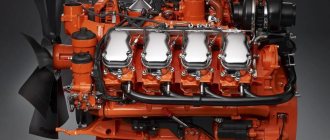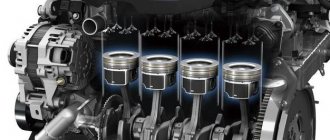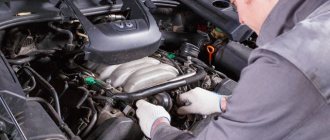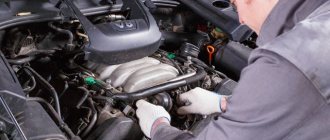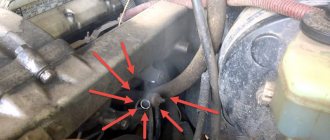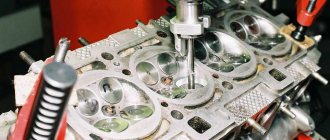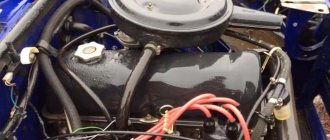In some European countries, there is a fine for prolonged warming up, no matter how cold it is outside, so most foreign manufacturers do not recommend warming up their cars. The main reason for this is environmental pollution.
Below we will try to figure out whether it is necessary to warm up a diesel engine with a turbine, we will indicate all the advantages and disadvantages of warming up, as well as the nuances of the engine’s functioning at different times of the year.
Warming up a diesel engine in winter
Even today, the question of whether to heat or not is relevant even today. Motorists are mainly divided into 2 camps, some say it is necessary, while others say the opposite. Car manufacturers write in their operating instructions that the engine must be warmed up at idle speed. But how and how much to heat diesel in winter?
There are 3 opinions:
- Warm up the diesel engine at idle speed until the power unit warms up.
- Warm up for about 3-5 minutes while you clear the car of snow.
- Get into the car, start it and drive away immediately.
Why is it worth warming up your diesel engine in winter?
Engine oil
Motor oil forms an oil film, providing the best friction, protecting internal components. Working without oil has a detrimental effect on the engine. And at 20 degrees below zero, motor oil, even with a viscosity of 10w-40, acquires a thick consistency. Even though there are special winter motor oils, they still thicken at low ambient temperatures.
Therefore, it is very important to select the right and high-quality motor oil for the winter. Oil is divided into summer and winter. Summer motor oil will simply thicken , it will be impossible to warm up or start the engine with such oil, and it can also lead to filter clogging.
- Too viscous oil makes it difficult to turn;
- Large gaps form in the mating parts; they are reduced only when warmed up;
- It is quite difficult for the oil pump to pump oil into the system.
During idle time, oil flows from the cylinder walls into the manifold, forming an oil film. And if the oil thickens, this film will not be enough, and the components will be left without lubrication, since too viscous oil will not be able to provide the necessary lubrication.
After running the engine at idle, the oil will warm up, after which the liquid will acquire the necessary viscosity and provide lubrication.
And this is the first argument in favor of heating diesel in winter.
Engine
The engine needs to warm up in order to prevent increased and rapid wear of internal parts. Parts at negative temperatures tend to decrease in size, which leads to an increase in gaps. A diesel engine operates with a higher compression ratio compared to a gasoline engine. As a result, the pistons work under load and wear increases significantly. After heating, the metal returns to its previous shape, as a result of which the operation of the motor becomes more efficient.
It is worth noting that when the engine is cold, cylinders and pistons experience very high loads and wear out quickly . And if you immediately start moving, the load will increase even more significantly. It's worth thinking about, do you need this?
Fuel
Warming up the diesel engine before driving in cold weather is also necessary to save diesel fuel. A cold, unheated engine “eats” much more fuel than a warmed one. All this is due to the fact that the formation of air-fuel mixture is difficult.
While driving, on average the engine warms up for about 9-10 minutes . And if you drive without warming up the engine during this period, the consumption will be much higher than the average when warmed up. Therefore, it is better to spend 5-8 minutes while the engine is warming up to clear snow and ice. After all, this is necessary to ensure traffic safety. Yes, and you'll save fuel.
In addition, at low negative temperatures there is a risk of diesel fuel freezing in the fuel system. The fact is that this type of fuel tends to lose fluidity at low temperatures. And the power unit may stall after a couple of kilometers without warming up. Therefore, it is better to warm it up first, making sure that there is normal fluidity and a stable fuel supply.
Another compelling argument in favor of heating diesel in winter.
Cold car interior and frozen windows
It is unlikely that you will be able to clear the glass of ice in cold weather; it will be easier to do this when the heater turns on and the interior warms up. And sitting in a cold cabin, even with heated seats and steering wheel, is not entirely comfortable. And if there are no heated seats, then sitting on a cold one is very harmful. Therefore, to ensure comfortable driving conditions, it is better to warm up the engine.
Harmfulness
Warming up a diesel engine is prohibited by law in some states. But it is worth remembering that the emissions of harmful substances from diesel are less than from gasoline. But diesel exhaust will not cause global harm to the environment, but it will easily extend the life of the engine.
Advice! Do not start your journey on a cold engine, or rather, wait until it reaches a temperature of at least 40 degrees. He can catch up with the rest on the way. But still, stick to the minimum value, since the operating temperature is 90 degrees.
Warming up the engine is an integral part of driving a car. In addition, this process does not take much time, which can be spent to benefit yourself and your car. Just don’t warm up your diesel engine under your neighbors’ windows, as it’s at least not polite.
Sources
- https://avtodvigateli.com/sovety-po-ehkspluatacii/progrev-dizelnogo-dvigatelya.html
- https://topdetal.ru/stati/ekspluatatsiya_i_progrev_dizeley_zimoy/
- https://www.dieselkraft.by/poleznaya-informatsiya/kak-i-skolko-nuzhno-progrevat-dizel-zimoj.html
- https://25cars.ru/sovety/progrevat-dizelnyj-dvigatel-zimoj.html
- https://aif.ru/auto/support/kak_morozy_ubivayut_turbirovannye_motory
- https://www.zr.ru/content/articles/923224-ostanovka-po-trebovaniyu/
- https://KrutiMotor.ru/dlya-chego-progrevat-dizel/
- https://auto-word.ru/skolko-gret-dizel-zimoj/
- https://autoassa.ru/blog/nuzhno-li-progrevat-dizelnyj-dvigatel-zimoj/
- https://AvtoSotka.ru/obzory-i-novosti/nado-li-gret-dizelnyj-dvigatel.html
- https://zen.yandex.ru/media/etlib/skolko-trebuetsia-vremeni-dlia-progreva-dizelnogo-dvigatelia-5c48511e54a86e00ad0e3bfa
Pros and cons of warming up a diesel engine in winter
On the topic of warming up a diesel engine in winter, many manufacturers say that modern turbo engines have a fuel injection system that allows you to start moving immediately. This is justified by the fact that the oil film is not washed off from the liners by fuel due to the correctly implemented supply of diesel fuel.
However, the fact remains that the oil thickens, and the diesel fuel also becomes viscous, and until it reaches the necessary parameters, it is still not worth starting to move.
We recommend, in our winter conditions, if possible, to warm up the engine to at least 40-50 degrees before the trip.
Advantages of warming up the engine at low temperatures:
- Optimal distribution of engine oil inside the engine, resulting in reduced wear. The engine is not subject to accelerated wear.
- The car has a smoother ride.
- Fuel economy. For the same time interval (10 minutes), the difference can differ by 3-4 times.
- Driving in a warm interior is much more pleasant.
Read also in the article - how to start a diesel car in cold weather.
Disadvantages of warming up the engine:
- Environmental pollution.
- Spark plugs are subject to high stress.
- Waiting for the engine to warm up.
Cylinder piston group and crankshaft
It is worth considering that warming up of a diesel engine is not uniform. Some parts heat up faster, others still remain cold. The internal combustion engine elements are made of metal and aluminum alloys (crankshaft, cylinders, pistons, shafts, etc.). As you know, when heated, the body expands, and the heating time and expansion coefficient depend on the material of manufacture.
It turns out that only after the motor reaches operating temperatures are optimal thermal clearances established and the rubbing pairs are properly lubricated. For this reason, immediate start of movement and additional loads on a cold engine reduce its service life.
How long does it take to heat a diesel engine in winter?
There are no specific instructions on how long to heat a diesel engine in winter. Do this at idle or while driving. Warming up the engine is not such a tedious and time-consuming task.
While you are clearing snow from your car or warming up the windows, the engine will warm up slightly. And then you can start moving without overloading it too much. The optimal warm-up time for a diesel engine while driving in winter is about 8-10 minutes. This time is enough for the coolant to warm up to 40-50 degrees.
In order to warm up a diesel engine in winter, you need to turn on the ignition and start the engine. Let it run for a bit and then start driving, about 8-10 minutes will be enough at low speeds.
After the diesel car engine warms up slightly (approximately 45 degrees), you can load the power unit more. While it has not warmed up, the driving style should be smooth, avoiding sharp accelerations and high speeds of the power unit. The engine will warm up completely while driving.
We do not recommend starting to drive if the engine temperature has not reached 40-50 degrees. If this cannot be avoided, for the first few km do not gain speed above 2 thousand, and do not accelerate more than 40 km/h. Remember that the operating temperature of the engine is 80-90 degrees, and until it warms up you should not subject it to excessive loads. Otherwise you will destroy him.
Is it necessary to warm up the turbodiesel at idle speed first? Yes, it is necessary, you need to spend the same 5-8 minutes on this. Although it warms up slower than its gasoline counterpart. After warming up at idle, the engine is usually warmed up while driving.
Turbo timer and circulation pumps
The recommendation immediately gave rise to the emergence of new electronic gadgets - turbo timers.
After turning the ignition key, the engine will run for a couple of minutes at minimum speed to cool the turbine and extend its service life. Developers of security systems were among the first to offer turbo timers, adding a new function to the alarm system for owners of turbocharged cars. The supply began to be in demand, and therefore separate electronic units appeared that perform the function of delayed engine shutdown. Turbo timers are not routinely installed even on cars with charged engines. And not because the problem has disappeared somewhere - nothing has fundamentally changed in the internal combustion engine. Yes, designs, materials and lubricants have changed and become more advanced, but turbochargers still do not like overheating. Maybe automakers use other means of protecting turbochargers from overheating?
Some companies (in particular, Porsche, Volkswagen, Skoda, Jaguar) install electric circulation pumps on many turbocharged models, which, if necessary, supply coolant to the turbocharger. Even after stopping the engine, antifreeze circulates through the unit for some time, preventing it from overheating. Reminiscent of a similar mode of operation of electric cooling system fans, implemented on most modern cars. The motor is turned off, but the fan continues to spin. It is clear that in this case there is no need for a turbo timer.
Many automakers shift the function of the intelligent turbo timer to the driver! Most instructions note that after operating the car in conditions close to the maximum permissible, it is recommended to let it run without load for several minutes before turning off the engine. That is, the advice remains the same as it was decades ago.
Last year, out of the 25 best-selling models in Russia, five were equipped with turbochargers. At the same time, an additional electric pump that cools the turbocharger is used in three models: Skoda Kodiaq, Skoda Octavia A7 and VW Tiguan. It turns out that most manufacturers of relatively affordable cars do not bother with such problems. The logic is simple: there is no increase in price, and the car is most likely out of warranty anyway. What next is the owner's concern.
Do not turn off the engine immediately - let it run at minimum speed. The operating conditions of a turbocharger are very difficult, and no innovations have appeared that would make it immortal.


